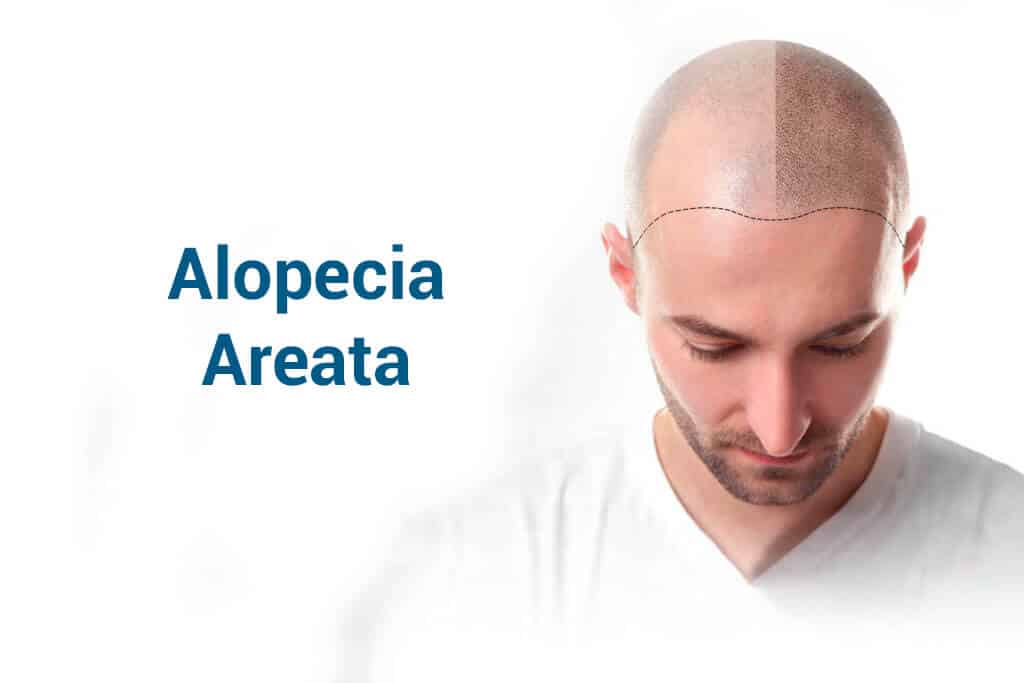ALOPECIA AREATA
Table of contents
Do you suffer from alopecia areataBe careful, because it completely conditions the result of a hair graft! Let's tell you everything you need to know about this pathology!
What is alopecia areata?
Alopecia areata is a type of non-scarring, autoimmune alopecia or baldness, which occurs both locally and in a generalised manner, with sudden hair loss occurring at any time in the life of a man or woman (although it often appears between the ages of 6 and 18).
Interestingly, it occurs on different parts of the body and not just the head, so your eyebrows, beard and even eyelashes (really any hairy area) can suffer from this problem.
Moreover, in some cases of non-temporary causation, if not treated properly, it will increase, affecting more and more areas and may culminate in total alopecia.
Do you want to get your hair back? We have the perfect solution for you!
Alopecia areata symptoms
Hair loss is very evident when suffering from this problem, as it falls into quite well-defined locks that allow the perfect vision of clapas on our scalp, that is, smooth areas of skin without hair. This hair loss, moreover, occurs quite quickly.
In addition to this, redness, scarring and flaking (similar to dandruff) may also occur. A step further includes the appearance of mild itchiness and, eye, a change in the appearance of the nails, which become ridged and/or pitted.
Diagnosis is usually straightforward if some of these symptoms are present, although it is advisable to have your scalp studied by an expert professional by means of a biopsy and to have the relevant tests carried out to check for autoimmune or thyroid conditions.
Causes of alopecia areata
The factors that produce it are autoimmune as well as psychological, which have a genetic basis, making it very difficult to fight when it appears.
It is also associated with infections, eye and tooth irritation, endocrine problems and head injuries.
Alopecia areata treatment; can it be cured?
There are several ways of dealing with this problem, generally similar to those that occur when suffering from similar diseases, the essence of which is to promote rapid hair growth. However, we are not talking about curative solutions, which do not exist at the moment.
Generally, anti-inflammatory drugs are used to work on our autoimmune system, usually local injections with triamcinolone and corticosteroid lotion or oral corticosteroids given in mini-pulses.
If these are not sufficient, a dermatological immunosuppressant may be prescribed, which, when administered, requires regular monitoring with blood tests. This treatment is often supplemented with vitamin D and calcium.
Obviously, in order to prescribe one treatment or another, both in terms of drugs and advice, it will be necessary to check the type of hair in question that the patient has, so that the treatment is as effective as possible while introducing the minimum of changes in the person.
ALOPECIA UNIVERSALIS AREATA
What is alopecia universalis areata?
This is a type of autoimmune baldness, i.e. our immune system attacks our cells, in this case, using antibodies to attack some of the cells found in the hair follicles.
This is, in fact, a variant of alopecia areata, but with a much more evident affectation.
Symptoms of alopecia universalis areata
This is very clearly differentiated, in an already advanced stage, as it involves the total loss of hair, not areas, and, in addition, the loss of the rest of the hair on our body (eyebrows, arms, beard...). This is not due to a problem with the hair or a lack of nutrients but to a state of hibernation of the follicle. It should be noted that the likelihood of hair reappearing is minimal.
In men it occurs firstly in the lateral and frontal areas and then in the crown of the head. Women begin to lose hair density in a diffuse manner, in all areas equally.
Causes of alopecia universalis areata
The cause of this pathology is not known. It is thought to be hereditary, although alopecia universalis does not occur in a high percentage of affected families. In fact, other autoimmune diseases do occur.
This has led to other options being considered, such as severe episodes of stress, as causes of this type of baldness, although it has not yet been possible to conclude whether it causes it or not, although we do know that, as with other types of alopecia, this is an aggravating factor.
Alopecia areata universal treatment; can it be cured?
Unfortunately, alopecia areata universalis cannot be cured and is very difficult to reverse. It is true that, although affected, the follicles are still alive under the scalp, so there is the possibility of seeing hair grow again, although, as we have said, it is highly improbable.
The most commonly used treatments are UV or ultraviolet light therapy, steroid injections and topically applied corticosteroids.
Treatment with tofacitinib citrate, a drug used to help improve the symptomatology of rheumatoid arthritis that, taken over long periods of time, has achieved successful results and is also known to reverse alopecia areata, is being tested.
Thus, if no results are achieved, the only solution is to wear natural hair wigs and micro-pigment small areas such as eyebrows.
